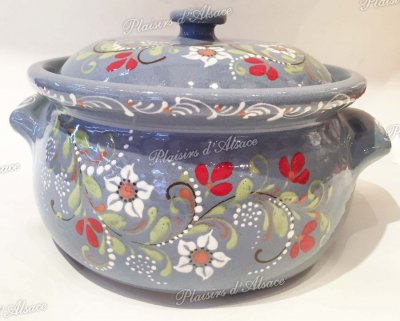Blue Flower Bowl
Description :
Our pottery comprises artisanal creations from Alsace, crafted entirely by hand from raw clay to finished products. Every piece is meticulously decorated by brush or with a barolet. The competition from cheaper markets and industrial manufacturing cannot be In the 12th century, Emperor Barbarossa granted the potters of Soufflenheim the “perpetual right,” allowing them to extract clay from the Haguenau forest.
Manufacturing Alsatian Pottery in Soufflenheim Initially, the freshly extracted clay from the ground spends some time in a mixer to soften it and make it more homogeneous. This process was once much more tedious, as the potter had to manually remove impurities from the soil before kneading it… sometimes with their feet.
The second phase, called shaping, is the most impressive: the simple lump of clay will transform on the potter’s wheel to reveal itself in the potter’s hands, here as a terrine for baeckeoffe.
Plates and kougelhopf molds are molded in plaster molds or matrices. At this stage, the potter proceeds with filling: handles and other details are applied using slip, which serves as glue.
The engobing process occurs just after drying and involves applying a colored clay film that will serve as a base color before decoration entrusted to female artists. Equipped with a barrel extended by a goose feather from which the colored engobe flows, they trace patterns and arabesques with a dexterity that is astonishing!
A layer of transparent glaze, necessary for waterproofing, is then applied to the kougelhopf molds and other objects before firing.
This final step is the ultimate factor before firing. While modern gas kilns now allow firing in 12-13 hours, in the past, it required four days!
Precautions for Using Kougelhopf Molds All kouglehopf molds are oven, microwave, and dishwasher safe. However, it is good to observe certain precautions: Avoid thermal shocks (sudden changes from cold to hot or vice versa). Do not place the kougelhopf mold directly on a heat source.



